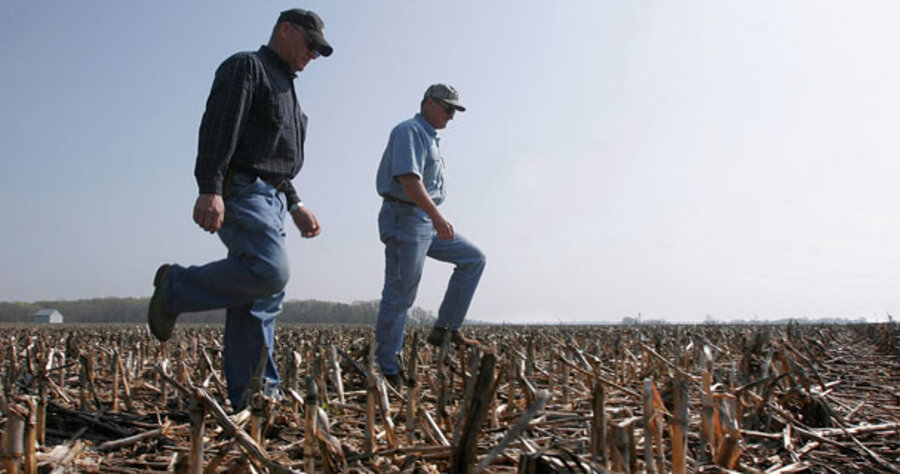More signs of trouble for corn
Loading...
| Chicago
Most years, Bob Biehl has all his corn in the ground by now. This year, he’s managed to plant just 40 of 600 acres on his farm in Belleville, Ill., just east of St. Louis.
“There’s still water sitting in the field,” says Mr. Biehl, who’s been farming in the area for more than 40 years. “If we get it planted in the next two weeks, provided we get the right rainfall this summer, we could still get a better crop than last year.... But come the end of May, there’ll be a lot of people worrying.”
A cold, wet spring has hindered Biehl and countless other farmers. While a good stretch of dry weather could still allow them to plant within their target window, the later the planting goes, the more likely it becomes that their harvest will be disappointing.
With corn prices already sky-high and concern rising about grain and food prices worldwide, any hiccup with this year’s crop could have serious implications. “What we’re looking at here is potentially even higher prices if there was a supply disruption,” says Chad Hart, an agricultural economist at Iowa State University in Ames.
There’s very little wiggle room for error, Mr. Hart says, given current demand for things like ethanol and feed and diminishing supplies of stockpiled grains. “On corn and soybeans, we are still looking at a pretty tight situation,” he says.
According to the crop progress report from the US Department of Agriculture on Monday, about 51 percent of the US corn crop has been planted, behind the five-year average of 77 percent. This actually represents a significant increase from the week before. Still, some states have been particularly delayed: Minnesota normally has 82 percent of its corn crop in by now, but this year, just 32 percent has been planted. In Iowa, where the average is also 82 percent, 46 percent of the crop is in the ground.
“You like to get it in between April 15 and May 10 or 15. That’s the primo time,” says John Hawkins, a spokesman with the Illinois Farm Bureau. “Once you get past May 15, the clock is starting to run out. When you get to Memorial Day, that’s when they start hitting the panic button.”
Mr. Hawkins and others emphasized that a late planting does not necessarily mean a poor crop in the fall, since so many weather factors throughout the summer play a part. But the worry is that the crucial “tasseling” period for the corn, when it pollinates, will come later – at the peak of summer heat.
The pressure to get the crop in has led some farmers to plant in less than ideal conditions, rather than waiting a few days for the soil to fully dry out. Some farmers have resorted to planting around, say, a one-acre wet patch.
“You have to start to wonder about the conditions that farmers are getting their crop into the ground in,” says Christian Mayer, a market adviser with Northstar Commodity in Minneapolis.
Dave Miller, director of research and commodity services with the Iowa Farm Bureau who farms 400 acres in the southern part of the state, is a prime example.
“I was planting in a field last night where probably 80 to 90 percent of the field was fit to plant,” Mr. Miller said last Friday. Some of the field was marginally OK, and “about 5 percent shouldn’t have had a tractor running through it,” he said. Miller planted anyway.
The poor weather has been one factor in the record-high futures prices for corn, more than $6 a bushel. Demand for ethanol, high wheat prices, and the low dollar have contributed as well. “It’s been the perfect storm,” Mr. Mayer says.
According to the latest USDA report on World Agricultural Supply and Demand Estimates, released last Friday, prices should remain high. The report predicts season averages at $5 to $6 a bushel – above the $4.10 to $4.40 predicted for the 2007 crop. It also projects that ethanol use will go up 33 percent.
Still, there’s little cause for worry at this point, says Jerry Norton, a grains analyst with the World Agricultural Outlook Board at the USDA and one of the authors of the report. High prices at the supermarket have much more to do with energy costs than the price of commodities, he notes, adding that it’s too early to assume this year’s corn crop will be poor.
“It’s still very favorable for corn,” Mr. Norton says. “People seem to be getting a little more alarmed than they should be.”
One unanswered question is how much corn farmers will be planting this year. According to USDA estimates, based on farmers’ intentions back in March, they’ll be planting 86 million acres of corn, 8 percent less than last year’s record planting. But in March, soybean prices were strong enough to make farmers want to switch more fields back to soy, and since then, corn prices have become even more favorable, some experts note. Thus many farmers may plant more corn than anticipated. On the other hand, if the wet conditions continue into June, it may seem safer to plant a field with more-forgiving soybeans.
“By May 24 or 25, you might have some people starting to switch,” says Miller of the Iowa Farm Bureau. He notes that he has about half of his 400 acres planted and is getting a little nervous about the fields he has left – in lower areas that take much longer to dry out.
“I’d like to be done,” he says. “And I suspect I’m similar to a lot of guys out here.... The degree of nervousness goes up exponentially over the next 10 days.”





